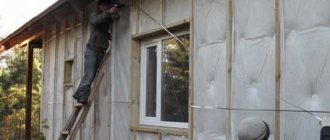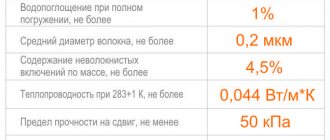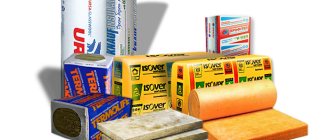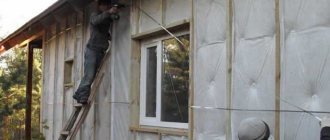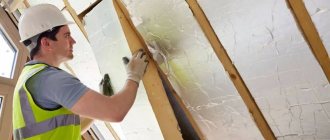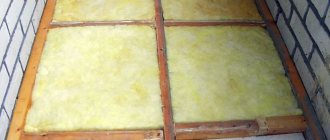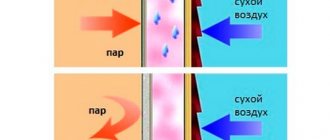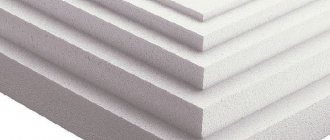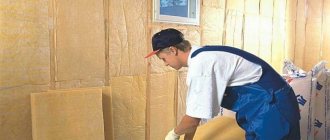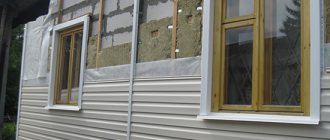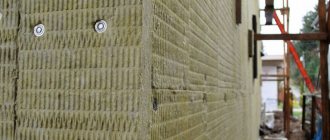The weather conditions of a short summer period and a long frosty winter suggest the use of additional thermal insulation during the construction of houses. The international construction market is saturated with various insulation materials, but experts recommend using mineral wool as an economical and effective material. Thermal insulation for finishing the foundation, walls or ceilings differs in its characteristics, so let’s look at which mineral wool is better for the ceiling and what insulation methods exist.
Characteristics of mineral wool
Thanks to its technical properties and easy-to-install dimensions, mineral wool has gained popularity not only among professional builders, but also among owners of private houses and apartments interested in insulating premises.
To maintain heat in apartments, almost all qualities of the material are important:
- environmental friendliness; fire resistance; water resistance; sound insulation properties; resistance to wear and rot.
Rolled mineral wool is the best option for ceiling insulation
The optimal set of useful properties is provided by the unique structure of mineral wool, which has no analogues among industrial thermal insulation products.
The only negative concerns the high degree of moisture absorption, but with proper installation of the panels it loses its relevance. To protect against condensation, rolls and mats are covered with a layer of waterproofing - thin impermeable foil. In the absence of protective foil, it is compensated for by an additional layer of polyethylene film and glassine, which acts as a vapor barrier.
When using foiled mineral wool, you can save on the purchase of waterproofing
Among the wide range of products, it is difficult to determine which mineral wool to choose for the ceiling in an apartment, and which for thermal insulation of a private house.
In fact, the easiest way to focus is on the type of packaging and layer thickness. Typically, products are produced in the form of mats, rolls (rolled slabs) and cylinders. The latter type is used for insulation of ventilation pipes, mats are used for external thermal insulation of foundations and floors in basements, so rolls are more suitable for housing.
Insulation with a thickness of 50-100 mm is suitable for apartments in multi-storey buildings, but for cottages thicker and denser rolls are needed - 150-200 mm in thickness, since there are most often unheated attic spaces above the living rooms.
Selection of mineral wool
Among materials for insulation, mineral wool is in increasingly growing demand. This is no coincidence. Let's start with the fact that this is an environmentally friendly material, safe for the environment and humans. Mineral wool has a high heat retention class, absorbs sounds well, is not afraid of rotting, open fire, and is not interesting to rodents and insects. Increased elasticity and dimensional stability predetermine easy installation without fasteners. Mineral wool does not break, crumble, or slide over time, providing reliable thermal protection for up to 50 years.
These characteristics are fully inherent in insulation based on Izover Profi mineral wool. It consists of long slabs in rolls, which are equally suitable for the entire house - ceiling, walls, flat (in frame structures) and pitched roofs (attics), balconies, interior partitions, ceilings above the basement. The improved thermal conductivity coefficient (0.037) will save up to 67% on heating costs when compared with uninsulated spaces. As is known, ordinary mineral wool suffers even when slightly wet - drops of water displace air from the fibers and are difficult to weather, which can lead to a decrease in thermal insulation properties over time. Thanks to the special AquaProtect technology, Izover Profi repels water well and dries much faster due to optimal vapor permeability.
Insulation with mineral wool
Buy at isover market
A nice bonus is savings on transportation and storage due to the increased compression ratio in the packaging - it can be easily loaded into a passenger car, taking up 3 times less space compared to conventional basalt slabs (35 sq. m Isover Pro versus 6 sq. m of ordinary mineral wool, The same amount can be placed on the roof rack if you load an Isover module from several packages there, compressed with high-strength film at the factory). We will consider insulation technology in detail below.
Brief overview of manufacturers
Nowadays it is easy to purchase products for any construction purpose, and mineral wool for the ceiling is no exception. Most likely, the supermarket will offer you several options that differ little from each other.
Brands known for excellent product quality and leaders in the thermal insulation products market:
- Knauf (Knauf - an international company); Isover (Isover - an international group); TechnoNIKOL (Russian corporation); Ursa (Ursa - a subsidiary of the Spanish group Uralita); Rockwool (an international group of companies headquartered in Denmark).
For insulating ceilings, both stone wool, produced on the basis of basalt rocks, and glass wool, which is produced after processing quartz sand and glass production waste, are suitable.
Diagram of one of the options for insulating the attic floor
Roll insulation
All insulators of this type have one strong point - the absence of joints in length, which as a result reduces heat loss. There is also a general drawback - roll insulation cannot be dense, like polystyrene foam, for example, since it is supplied rolled up.
Foiled mineral wool
The thermal insulation and other properties of rolled mineral wool are similar to their slab counterparts, the main differences being the length of the mat and the foil coating. The foil layer on one side of the insulation reflects infrared radiation, further preventing heat loss. The aluminum film prevents moisture-sensitive cotton wool from getting wet.
Foil-coated isolon (penofol)
A relatively new insulation material, which is based on porous polyethylene, and one of the sides is covered with aluminum foil or a special metallized film. It is most often used indoors, including for ceiling insulation. Penofol does not come in thicker than 10 mm, which, together with the polyethylene base, does not significantly prevent heat loss.
In rooms with low levels of infrared radiation it does not give much effect, therefore it is often used in combination with other insulation materials, for example, mineral wool.
Self-adhesive options are available, making installation much easier. When insulating with foil materials, you cannot completely cover the reflective layer, as the reflection effect will disappear. To prevent this from happening, you need to leave a ventilation gap of 15-20 mm.
It is usually secured with staples!How to properly insulate a ceiling
The installation of ceiling tiles should be given special attention, because improper installation of mineral wool on the ceiling will result in the loss of its thermal insulation properties - during the first year the characteristics deteriorate by about 40%.
In addition to insulation, you will need tools and fasteners:
- self-tapping screws, plastic fasteners, nails; a set of counter slats; a metal profile with hangers; a screwdriver; a tape measure, a hammer; a stationery knife with a thin blade; glue for insulation.
The correct calculation of the material will be made right in the store, if you provide data on the working surface area.
Laying insulation on a metal suspended ceiling profile
Insulation installation options
At the moment, there are two options for attaching any type of insulation and several additional ones, which I will also mention. By the way, these fastening methods can be used to install both loose insulation and denser slabs.
The main methods of attaching insulation to the wall:
- Using glue;
- Mechanically, thanks to special dowels.
Let's consider each mounting option separately.
On glue
Cement-based adhesives must be mixed in a container with cold water before use. Stir the dry composition in water until a thick, homogeneous mass is obtained, reminiscent of the consistency of rich sour cream.
It is important to ensure that no lumps form when diluting the adhesive powder, as this may reduce the quality of the composition.
The glue, of course, is not mixed by hand; for this you need to use a special mixer attachment, which, put on a drill or hammer drill, mixes the dry mixture with the liquid at low speeds.
You need to apply glue to the inside of the insulation board, and in order for the glue to bond the insulation to the wall as well as possible, the outside of the insulation needs to be made rough. To achieve this, I recommend using a special roller or brush for working with foam.
In addition, it is necessary to increase the adhesion of the walls. No, you don’t need to make it rough, it’s usually like that from the very beginning. It is enough to coat the surface with a high-quality primer and let it dry. After this, you can install the insulation on the walls.
Related article: Fashionable wallpaper in the living room: photos in the apartment, combined options
For dowels
The second most common method of fixing insulation to walls. Sometimes installing thermal insulation on dowels acts as the main method, but more often, it is an addition to installation with glue for more reliable fastening.
All types of insulation, from polystyrene foam to mineral wool, are attached to special dowels that look like mushrooms with a cap. For example, a foam board is first attached to the wall with glue, and then fixed with several umbrellas.
Mineral wool is usually simply applied to the surface and five holes are made through it in the wall, one in the center and four in the corners of the slab. Holes are made in foam plastic in the same way.
After this, a dowel with a cap is driven into the holes until the cap presses the slab against the wall, then an expanding plastic nail is inserted into the dowel, which, using a hammer, firmly secures the dowel in the wall, and as a result, the insulation is securely held in place .
Other technologies
If insulation is carried out with chipboard or OSB panels, then the slabs of this material are attached to the surface with special brackets. Some roll insulation, for example foil, is sometimes produced with an adhesive composition already applied to the inside of the insulation.
Sometimes, fasteners, as such, are not needed at all. This occurs when insulation, usually loose insulation such as mineral wool, is laid flat against a special wooden frame.
Some insulation materials are glued to the wall, just like wallpaper; for example, cork insulation. There is also heat-insulating paint, which is applied to the surface using an ordinary brush or roller.
Instructions for internal thermal insulation
Internal insulation is most often carried out in city apartments. Pay attention to how to attach mineral wool to the ceiling: a mandatory step is the construction of the frame.
Main stages of work:
Creating metal profile lathing for suspended ceilings or boards. The profile has certain standards, and for a wooden frame, boards with a cross section of 30 x 100 mm or 40 x 200 mm are suitable - the heavier the thermal insulation boards, the more powerful the frame.
The profile slats are attached to the ceiling with dowels on hangers, the distance between them is approximately 55-60 cm (the most convenient for laying slabs). Insulation of the ceiling in a private house on a wooden sheathing. Attaching waterproofing (using simple mineral wool). The thick film is cut into strips slightly wider than the intervals between the slats - 65-70 cm.
For fixing to a wooden base, thin counter-battens and nails are used, and screws are used to a metal profile. Laying insulation. Mineral wool is fixed in two ways: with a construction stapler or using special glue. At the same time, a vapor barrier layer, which is the top one, is also installed.
Glassine is considered a good vapor barrier; mineral wool glue is suitable for fixing it. One of the methods of laying thermal insulation slabs is along beams. Strengthening the thermal insulation with transverse slats. The result of the work should be a stable, durable three-layer “pie” without gaps between the plates.
On the bottom side, sheets of plasterboard are attached to the profile, completely covering the thermal insulation pad. The result is an insulated suspended structure, which is subsequently equipped with lamps and decorated in accordance with the design project.
What you will need for installation
This material can usually be found in two forms:
- rolls in which the layer thickness reaches 5 cm;
- slabs or mats 10 cm thick.
Scheme for insulating a ceiling in a private house.
A mandatory criterion for selection is the presence of a layer of foil on one of the sides. This layer serves as a waterproofing agent, and if it is not there, you will have to buy foil separately or purchase foil-coated polyethylene foam. However, it can be completely replaced with polyethylene film. The main thing is that there are no holes in it, and its density is high. Glassine is most often used for vapor barrier. You will also need:
- screws and drill;
- construction stapler;
- wooden boards and beams or metal profiles;
- glue for synthetic materials;
- stationery or garden knife;
- nails and hammer;
- measuring instruments;
- thick gloves, respirator, safety glasses.
After acquiring all the tools, you can get down to business. Under no circumstances should you work with mineral wool without a set of protective accessories. It consists of thin synthetic fibers that can crumble and break, and if it gets into the respiratory tract or mucous membranes, irritation will occur at best, and severe and dangerous inflammation at worst.
In more detail: “Vapor barrier in wooden floors
Stages of external thermal insulation
For external insulation, the presence of an attic non-residential space is required. The process of laying mineral wool is simpler than during interior work and takes less time, because the mineral wool is attached not to the ceiling, but to the floor.
We follow the following procedure:
We cover the entire area of the attic floor with a layer of glassine, laying the sheets overlapping (10-15 cm is enough). We glue the joints or reinforce them with tape.
The effectiveness of the vapor barrier layer will increase several times if it is reinforced with sheets of 5-centimeter polystyrene foam. We lay rolled mineral wool of the standard 150-200 mm. We make sure that there are no gaps between the plates. If the rolls are covered with foil on one side, the insulation process ends here.
The sheets must be positioned so that the foil is on top. We fix the material with slats; it is not recommended to pierce the thermal insulation directly with nails. We stretch a thick film over simple mineral wool (without foil) (you can use greenhouse film) and fix it with slats. We glue all joints and joints with double-sided or regular tape.
External insulation with mineral wool - laying slabs on the attic floor
A floor made of any available material is laid on top: chipboards, plywood, boards. Sometimes the roof also requires additional insulation. Thermal insulation is carried out according to the same principle as the option for apartments, but with one caveat - instead of a powerful frame, a light sheathing of counter-battens is sufficient.
DIY ceiling insulation
There are three methods of insulation depending on the building design:
- external (from the attic or attic);
- internal (in the presence of high ceilings, since it can take away from 150 to 350 mm of the room’s height);
- combined method (used more often for baths, saunas, where exits and communication openings are provided in the ceiling).
If it is necessary to insulate the space under the summer attic (cold or insufficiently insulated), and the ceiling height is small, it is better to thermally insulate not the ceiling, but the floor in the upper room (make sure in advance that the vapor barrier layer on the ceiling of the warm room is present and sealed). The process follows a pattern already familiar to us. You must first clean the floor and, if necessary, cover it hermetically with a vapor barrier (do not forget to seal the joints with special adhesive tape). Then comes the mineral wool between the additionally installed joists. On top there is a waterproofing film and a subfloor.
Combined method of insulation
Thermal insulation of the ceiling on both sides in residential buildings is done extremely rarely; it is usually necessary for equipping rooms in which heat is maintained for a long time: steam rooms, saunas, baths. Sometimes double insulation is important in houses with irregular or stove heating. You already know which thermal insulation to choose or how to fix mineral wool on the ceiling; all that remains is to choose the order of work: you can start with both external and internal insulation.
The results of work on insulating residential premises are immediately noticeable - the house becomes warm, dry and cozy.
The ceiling is one of the most important attributes of a room. Its appearance should not only be attractive, but also have protective functions.
The insulation is attached to the ceiling using various types of means and materials. The main and most used of them is considered to be mineral wool; it is the one that has the most advantages in its use. In the modern world, the ceiling plays not only a decorative role, but also performs a number of mandatory functions, such as:
- Noise. Protective. Thermal insulation.
Ceiling insulation with stone wool
- Cream for joints for arthritis and arthrosis – Artreid
- Abdominal Bioliposucker for weight loss in the abdomen and thighs
- How to use Upsize cream to enlarge your breasts by 2 sizes at home
Ceiling insulation with stone wool is an inexpensive way to prevent heat loss through the ceiling, whether installed inside or outside the room. The quality of work depends on competently performed operations, so in this article we will consider the rules for placing and attaching the insulator to the surface in various situations. Using our recommendations, you can avoid unnecessary financial costs and common mistakes when insulating.
Features of thermal insulation of ceilings with stone wool
Stone wool is a fibrous insulator made from basalt. To improve its characteristics, various substances, including hydrophobic ones, are introduced into its composition. The material is quite loose, saturated with an inert substance, and does not allow heat to pass through.
To avoid skin irritation, wear thick clothing with long sleeves and gloves. To protect your eyes and respiratory system, wear goggles and a respirator. After work, change your clothes.
It is often said that cotton wool is very dangerous, but this statement is not true. Modern technologies completely isolate the coating from the living space, and it will not bring trouble to anyone.
Advantages and disadvantages of ceiling insulation with stone wool
The fibrous material has unique characteristics, thanks to which it is considered the best among similar products.
- Very low thermal conductivity, which creates a comfortable indoor environment.
Users should be aware of the problems that sometimes arise when operating a room insulated with cotton wool:
Unscrupulous sellers may sell low-grade goods with a high percentage of toxic elements.
Technology for installing stone wool on the ceiling
Preparatory work
Before insulating the ceiling with stone wool, inspect it for defects and eliminate any deficiencies. The insulator is not afraid of irregularities less than 3 mm; more serious defects will have to be removed.
- Clean the ceiling from decorative coating and plaster.
Selection of stone wool
The components of the insulating “pie” must be of high quality. In order not to doubt the purchased product, control the following points:
Storage conditions for stone wool for ceilings. The ideal option is to store the product in a dry room.
For thermal insulation, purchase products with the following technical characteristics:
- Density
_ Not less than 80 g/m3. The higher the value, the greater the mechanical load the coating can withstand. The value is relevant for insulation from the attic side.
- Read about Virgin Star cream-gel for vaginal tightening
- How to lose 20 kg - real reviews on Guarchibao
Installation of basalt wool from inside the room
The technology for insulating the ceiling with stone wool depends on the method of fastening the material. From the side of the room, the insulator is attached using several methods:
- Laying in the frame
. It is used if it is planned to make a suspended ceiling underneath. The frame is assembled from wooden blocks 40×40 mm or metal profiles, which are used for fastening drywall. The choice of material for lathing depends mainly on the financial viability of the owner of the house, but metal products last longer. If you plan to use lumber, treat it with antiseptic agents, despite the fact that the structure is located indoors. It won't hurt to be on the safe side.
The procedure for using the lathing is as follows:
Attach the frame to the ceiling, placing the slats parallel to the window. The distance between them should be 1-2 cm less than the width of the insulation. The insulator is soft, after installation it will occupy the entire space and cover the sheathing. Connect the frame elements together with corners, and the structure itself with dowels.
If the boards stick, perform the following operations:
- Make sure the surface is ready for application.
Tips for working with dowels:
Do not hammer the hardware too deep; the cap should not sink more than 1 cm.
Laying stone wool on the ceiling outside
Laying stone wool outside is easy, no ladder required and no need to stand with your hands up. This method is used when the premises have already undergone major renovations.
- Before insulating the ceiling with basalt wool, clear the attic of debris. If there is a subfloor, remove it.
How to insulate a ceiling with stone wool - watch the video:
Stone wool is made from natural, environmentally friendly material. If you have done the insulation correctly, you will enjoy the warmth and comfort of your home for many years.
Mineral wool
Mineral wool is a fiber made from textiles.
It can be purchased in the form of rolls or blocks. The one made in the form of a path has greater thermal insulation. It not only has better performance properties, but it is also much easier to work with.
How to attach insulation to the ceiling using mineral wool? Let's look into this issue.
Thanks to cotton wool, it becomes possible not only to insulate, but also to protect the room from excessive noise, as it has excellent sound insulation properties. The installation itself is carried out using dowels with a wide head. Additional means for more durable fastening can be self-tapping screws and self-adhesive tapes.
Mineral wool on the ceiling
The installation instructions include the following work steps:
Measurements are taken from the ceiling on which installation is planned. Preparation of the slabs. They must correspond to the measurements taken and be completely identical. Holes for dowels are drilled in the ceiling. In this case, it is better to use plastic ones. With their help, metal profiles are installed on the base. Mineral insulation is applied to the profiles. After applying mineral wool, the entire structure is secured with dowels. Sheets are laid on top.
They also need to be secured as best as possible. This can be done using wooden slats and nails that resemble mushrooms in appearance. They received this name because of their wide cap on top. During installation, cracks and openings may remain, which it is advisable to fill with polyurethane foam.
Fastening mineral wool insulation has its advantages, such as:
- This material has high environmental parameters. It is hypoallergenic. Durable in use, thanks to the high quality of the products used. It is not subject to deformation. It is a fireproof material, which expands the range of its use. Application is possible even in bathhouses or saunas. High percentage of vapor permeability.
One of the important aspects in installation is that during installation the material itself must be placed tightly, but in no case be subject to deformation. Otherwise, it may lose its performance properties.
For a longer period of operation, it is advisable to coat the surface with an antifungal agent upon completion of installation work. This will allow further dust collection.
Preparing mineral wool for installation on the ceiling
At the very beginning of the thermal insulation process, before insulating the ceiling with mineral wool in a frame house with your own hands, you need to calculate the volume of insulation. It is also worth preparing the tools:
- glue;
- beam;
- metal scissors;
- dowel-nails;
- staples;
- scotch;
- film waterproofing material.
You must remember to prepare protective equipment. They use goggles, clothes (they will most likely go to waste after work), prepare a respirator and gloves. This is due to the fact that when performing work without special clothing, the body will itch, since the mineral wool fibers begin to crumble when attached. Also, it is difficult to breathe in such a room if special protective equipment is not used.
On a note!
The material is unpacked only before installation on the frame.
Polyethylene foam and polyplex
In addition to mineral wool, attaching insulation to the ceiling can be done using other materials, such as:
Foil polyethylene foam.
In appearance, it is polyethylene foamed in a special way and subsequently glued to aluminum foil. You can find a similar look in rolls. Their width is standard and reaches one meter, and the thickness can vary from one to twenty centimeters.
It can be used either independently or used in combination with mineral wool to improve the thermal barrier. Also, this combination makes it possible to protect against various carcinogens that can appear due to the use of cotton wool.
Polyplex is the result of extrusion of polystyrene foam.
It can be purchased in the form of sheets measuring 60*120 centimeters. The thickness can vary: from one to twenty centimeters. Among the advantages, one can highlight the increased density, due to which it has found its use not only in the form of insulation, but also as a rough base for putty.
From the above we can conclude that both types have their advantages and their installation can be done independently. The polyethylene foam is fastened by gluing it with special glue or using dowels, widely used in construction. The polyplex is attached with dowels or holders that look like the letter P.
Advantages
Mineral wool attracts craftsmen with its advantages. Let's dwell on the basic advantages of the material.
- Convenience. When used and installed, mineral wool is very convenient. The material is produced in the format of plates and rolls. They are easy to unfold, cut, fasten, and also make indentations for the passage of communications.
- Availability. The minimum cost of insulation also largely determined its demand on the market. The material is economical, but at the same time remains reliable, of high quality, and helps to achieve results.
- Increased fire resistance. During repairs and finishing, the possibility of fire should be considered. It is recommended to give preference to safe materials that do not support combustion. Mineral wool attracts with its fire resistance. In addition, it prevents the spread of fire throughout the room.
- Density. Thanks to its increased density and fibrous structure, the material guarantees the maintenance of an excellent microclimate. In addition, decent sound insulation is provided.
- Minimum weight. It is especially convenient to work with such insulation: the weight is relatively light, so even insulating the ceiling does not involve large physical costs.
- Durability. Mineral wool retains its properties, structure well, and performs all functions. Of great importance here is the fact that the material is not afraid of all kinds of pests.
- Ecological cleanliness. The material is completely safe. It is important to remember that mineral wool has structural features: small particles can enter the respiratory tract and crumble. Therefore, when working with insulation, it is necessary to take precautions and use protective equipment.
- Strength. Mineral wool can cope with negative mechanical influences and serious loads.
- Optimal vapor permeability. This excellent property has become universal: excessive evaporation is prevented in cold winters, and protection against overheating is provided in summer.
- No pungent odor. You can safely use insulation in residential areas.
It is very important to choose the right size of mineral wool
Foam plastic and expanded clay
Polystyrene foam in appearance resembles foamed plastic material with a cellular structure. It is usually produced in size meter by meter and is used not only as internal, but also external insulation. Its thickness can vary from twenty to one hundred centimeters.
This depends on the type of finishing required. Can be used as a base for ceiling putty. Another feature is its ability to level surfaces.
Polystyrene foam is not only convenient to use, it also has a number of advantages, such as:
- Has proven itself as a universal remedy. Quite low cost. Based on this factor, this makes it more accessible to the population. Durable in use. Provides a very high level of reliability of room protection. Has good thermal insulation.
The main component of expanded clay is clay, from which it is subsequently made. It looks like balls and is easy to insulate a room with. The principle of working with it is to backfill it in the attic, so it is only relevant in private homes.
When insulating the roof of a house with expanded clay, you can use these useful instructions to help you carry out the installation correctly. These tips include specific actions such as:
- The work process should begin directly with the installation of waterproofing. The choice of means for it is quite large, and all of them are ideal for carrying out this process. It is necessary to cover the rafters and chimney pipe prematurely. For a better vapor barrier effect, a layer of clay should be laid on it. Expanded clay is laid out in layers of at least 15 cm. Thus, thermal insulation is significantly increased .
Expanded clay has a number of advantages, such as:
- It is one of the materials that does not decompose over time. Others can harbor various insects and small rodents. Expanded clay completely eliminates this possibility. It is considered fire-resistant and fireproof. It has good sound insulation. It is waterproof. It has frost resistance, which is very important in winter. It has high heat transfer. It is quite low in cost due to the materials from which it is made. It is used not only for ceilings . It can also be used for foundations and walls.
Fastening foam with glue
The first thing you need to do is find out how smooth the wall you are going to insulate is; a lot depends on this, for example, the method of applying the glue. If the surface is flat, then glue is applied to the insulation, but if the surface has differences, then the adhesive mixture is applied to the wall itself using a spatula. If the load-bearing surface is heavily littered, it must be leveled by plastering.
So, let’s say the wall of our hypothetical house is more or less even, we can begin installation. We clean the wall from dust and debris, repair cracks and chips, and prime it thoroughly.
While the primer dries, you need to secure a support strip at the bottom of the wall, with a thickness equal to the size of the slab. This is necessary to ensure that the slabs do not slide under their own weight.
After the primer has dried, mix the glue as described above, following the instructions written on the package. Using a needle roller, walk along the inside of the insulation and apply the glue. It should be left at five points, in the center and in the corners, do not skimp on the glue, the points should be quite massive. After this, proceed to install the foam plastic, from bottom to top, holding each slab for about a minute so that the glue sets.
Insulation from above
Insulation implies various methods of attaching insulation. Today two types are known:
The upper one provides for insulation from the attic of the house, which is quite relevant for private houses. The process includes a sequence of actions such as:
- The first stage is the filing of the beams. Laying of insulation. After which the insulation material itself is directly laid. The final step is the cladding. You can use a board for it. This is done to allow free movement around the perimeter of the attic.
The advantage is that you can use any type of insulation, even in bulk form, such as expanded clay. An important feature that you should pay attention to when laying is that during the process itself it is very important not to leave empty space.
Regardless of the method, for installation you will need tools such as:
- Knife or hacksaw. Nails. Various screws. Hammer. Grinder. Electric drill. Stapler designed specifically for construction work. Polyurethane foam. Profiles. Screwdriver. Self-tapping screws. Dowels.
Principle of operation
To understand the principle of operation of such insulation, consider the main methods of transferring heat from one coating to another:
- thermal conductivity - the ability to conduct heat (solids);
- convection - heat transfer through the air due to different densities of cold and warm air currents;
- radiation - any body with a temperature above zero emits heat waves, which are absorbed by walls and ceilings (surfaces), converted into heat and transferred to the cold external environment. This exchange accounts for about 60-90% of heat loss.
Thus, heat loss is inevitable. It turns out that to create the effect of thermal insulation, it is necessary to minimize heat loss from radiation. But traditional TIMs are not able to protect a building from this type of heat transfer. And the optimal material was found - foil insulation, known for its reflective and low-emissivity properties.
Insulation from below
This type involves the process itself directly from the bottom of the ceiling itself. Materials made in rolls or beams are ideal for it.
This method is considered more difficult and labor-intensive. The process itself includes the following stages of work:
- It is necessary to make the fastening using hemming. If this was not possible, you can build up beams on which the installation will be carried out in the future. If it is done using foam plastic, then the process itself is greatly simplified. It can simply be glued to the ceiling. But after this, to increase reliability, it should be additionally secured with dowels intended for these types of work. After the installation process, the ceiling itself, if its condition requires it, can be decorated by painting or using putty.
Thus, you can carry out the fastening with your own hands. The main criterion is the presence of either a suspended frame or specially made fastenings.
If the ceiling height is low, it is better to opt for foil-coated polyethylene foam. The profiles on which they will subsequently be attached can be made of metal or wood. After insulation is completed, if desired, the ceiling can be decorated in various ways, the main ones being painting or installing a stretch ceiling.
Today there is a huge selection of insulation materials that can not only retain heat in your home, but also provide good sound insulation, which is quite important in multi-story panel or brick houses.
- Date: 02/05/2015 Comments: Rating: 15
Warmth and comfort in the home are one of the first tasks that need to be solved for a comfortable life and preservation of health. In the modern world, where the daily rise in price of energy resources is by no means new, the issue of insulating living quarters is acute.
Scheme of insulation and soundproofing of a wooden ceiling.
To ensure the safety of heat from below, “warm floors” are used; to prevent it from escaping through walls and windows, plastic structures are used.
But it is extremely important to pay attention to heat loss through the ceiling. This is due to the fact that more than 30% of all heat is concentrated at the top of the room. If adequate thermal insulation is not maintained, this will inevitably lead to condensation settling, an increase in the amount of moisture and, as a result, the formation of mold.
How to avoid this, you ask? Is it possible to insulate a ceiling with your own hands?
Of course. In addition, it is quite simple to do, without spending a large amount of effort and material investments. You just need to properly understand the question of how to attach the insulation to the ceiling?
Before considering the issue of attaching insulation to the ceiling, you should pay attention to such an important aspect as the types of insulation. What is the material with which you will insulate your ceiling? After all, only after deciding on this issue, you can purchase it and start mounting it.
Types of fasteners for thermal insulation
Dowels used for fastening various types of insulation are divided according to the material of manufacture and their design. The dowel for insulation can be either plastic or steel, and also equipped with a thermal head. Plastic umbrellas are also divided into:
- polypropylene;
- nylon.
These products also differ in the method of fastening, when the core is screwed into the insulated surface, and when it is simply driven in with a hammer.
Features of plastic fasteners
Products made from propylene differ from all others in that they have cone-shaped holes in the umbrella, which promote better adhesion of the product to the insulation. Nylon fasteners, called rondoles, are used for fastening light and soft materials.
Similar products are made from high-strength polypropylene, polyamide or nylon. The main advantage of such fungi is:
- good resistance to aggressive environments;
- low cost;
- reduced thermal conductivity, as a result of which cold bridges are not created;
- ability to withstand significant temperature changes;
- long service life - they do not rust or rot;
- can withstand a load of almost 400 kg/m2.
Plastic mushrooms can be used when attaching thermal insulation to concrete and brick walls. One of the disadvantages is the impossibility, after insulation, of finishing surfaces with a material with a high specific gravity.
Metal fasteners - advantages and disadvantages
The core of such a product, made of galvanized steel or, in rare cases, polyamide, is inserted into a polypropylene sleeve that has spacers at the bottom. Its size exceeds other fungal models. But the ability to withstand loads is also high - up to 750/m2, which allows finishing with any materials, both light and heavy. The disadvantages include the following:
- high price;
- formation of cold bridges and condensation at the entry points of the metal rod into the base surface;
- poor resistance to moisture, as a result of which rusty spots may appear on the surface of the plaster.
Thermal Head Fasteners
Mushrooms with a thermal head are a metal core that is coated with durable polyamide. The upper part of the metal nail is equipped with a plastic part, which eliminates the formation of cold bridges at the points where the fastener passes. Such products are most often used when insulating wooden structures. All the advantages inherent in metal and plastic mushrooms apply to fasteners with a thermal head, with the exception of the price, which significantly exceeds the cost of all other fasteners of this type.
